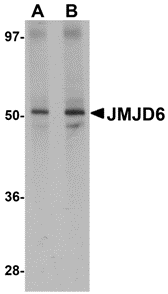Catalog# : 5383
The jumonji domain-containing protein (JMJD) family is defined by the presence of the JmjC domain that is observed in several diverse species. JMJD6 was initially identified as a membrane protein that participates in phagocytosis but recent studies have shown that it has other functions when it is expressed in the cytosol and nucleus. JMJD6 is thought to play important roles in regulation of development and differentiation as knockdown experiments in mice resulted in neonatal lethality with severe defects in the morphology of numerous organs. JMJD6 also can catalyze the lysyl-hydroxylation of U2AF65, a protein involved with RNA splicing, suggesting that some of the functions attributed to JMJD6 may be due to its regulatory activity of RNA splicing.
Additional Names : JMJD6, Jumonji domain-containing protein 6, phosphatidylserine receptor, PTDSR, PSR
 Description
DescriptionLeft: Western blot analysis of JMJD6 in human brain tissue lysate with JMJD6 antibody at (A) 1 and (B) 2 µg/ml.
Source : JMJD6 antibody was raised against a 15 amino acid peptide from near the amino terminus of human JMJD6.
Purification : Affinity chromatography purified via peptide column
Clonality and Clone : Polyclonal
Host : JMJD6 antibody was raised in rabbit. Please use anti-rabbit secondary antibodies.
Application : JMJD6 antibody can be used for detection of JMJD6 by Western blot at 1 - 2 µg/ml.
Tested Application(s) : E, WB
Buffer : Antibody is supplied in PBS containing 0.02% sodium azide.
Blocking Peptide : Cat.No. 5383P - JMJD6 Peptide
Long-Term Storage : JMJD6 antibody can be stored at 4ºC, stable for one year. As with all antibodies care should be taken to avoid repeated freeze thaw cycles. Antibodies should not be exposed to prolonged high temperatures.
Positive Control
1. Cat. No. 1303 - Human Brain Tissue Lysate
Species Reactivity :H, M, R
GI Number : 67461014
Accession Number : Q6NYC1
Short Description : Jumonji domain-containing protein 6
References
1. Takeuchi T, Watanabe Y, Takano-Shimizu T, et al. Roles of jumonji and jumonji family genes in chromatin regulation and development. Dev. Dyn. 2006; 235:2449-59.
2. Fadok VA, Bratton DL, Rose DM, et al. A receptor for phosphatidylserine-specific clearance of apoptotic cells. Nature 2000; 405:85-90.
3. Zakharova L, Dadsetan S, and Fomina AF. Endogenous JMJD6 gene product is expressed at the cell surface and regulates phagocytosis in immature monocyte-like activated THP-1 cells. J. Cell. Phys. 2009; 221:84-91.
4. Bose J, Gruber AD, Helming L, et al. The phosphatidylserine receptor has essential functions during embryogenesis but not in apoptotic cell removal. J. Biol. 2004; 3:15.

No comments:
Post a Comment